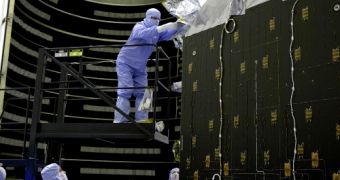Officials at NASA announce that the agency's latest space probe, the Mars Atmosphere and Volatile EvolutioN (MAVEN) orbiter, is currently on track for a planned Monday, November 18 launch date. Liftoff will occur at 18:28 UTC, from the USAF Cape Canaveral Air Force Station, in Florida.
The $671 (€500.5) million mission only has a few hours available for blast off in this launch window. NASA TV will be broadcasting a live feed from the launch pad, as well as extensive coverage of the orbiter's mission and capabilities, Space reports.
The spacecraft was developed by a collaboration of experts from the University of California in Berkeley, the University of Colorado in Boulder, Lockheed Martin and the NASA Goddard Space Flight Center, in Greenbelt, Maryland.
MAVEN will launch aboard an Atlas V delivery system, and will begin its trip to the Red Planet shortly thereafter. Experts calculate that it will achieve orbital insertion around Mars some 10 months later, on September 22, 2014 – just a couple of days following the Indian Space Research Organization's Mars Orbiter Mission.
The objective of this new mission is to investigate the Martian atmosphere in exquisite detail, to find the origins of its mysterious methane emissions, and also to investigate how charged particles emanating from the Sun strip away our neighboring planet's atmosphere piece by piece.
The 2.5-ton (5,410-pound) orbiter features three suites of scientific instruments: the Particles and Field (P&F) Package, the Remote Sensing (RS) Package and the Neutral Gas and Ion Mass Spectrometer (NGIMS) Package.
The P&F suite includes the Solar Wind Electron Analyzer, the Solar Wind Ion Analyzer, the SupraThermal And Thermal Ion Composition instrument, the Solar Energetic Particle (SEP) instrument, the Langmuir Probe and Waves (LPW) instrument and a magnetometer.
The RS package contains just the Imaging Ultraviolet Spectrometer (IUVS). The NIMS suite features sensors responsible for measuring large scale traits of the upper Martian atmosphere, particularly the planet's ionosphere.
“A maven is a trusted expert based on an accumulation of knowledge who seeks to pass that knowledge onto others. MAVEN, like its entomological origin, will indeed establish the knowledge on which scientists can build a story of the Mars atmosphere and help future human explorers who journey to Mars and the Mars surface,” NAS SMD associate administrator John Grunsfeld said last month.

 14 DAY TRIAL //
14 DAY TRIAL //